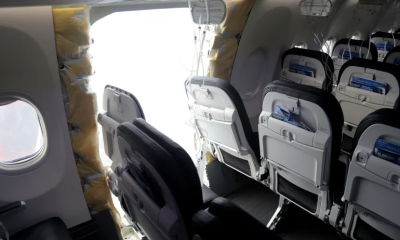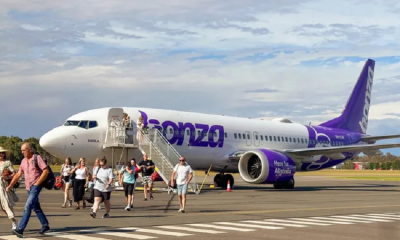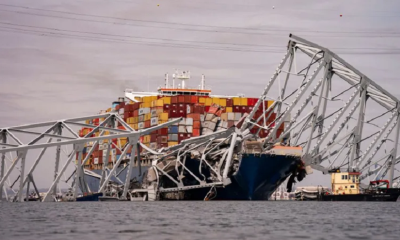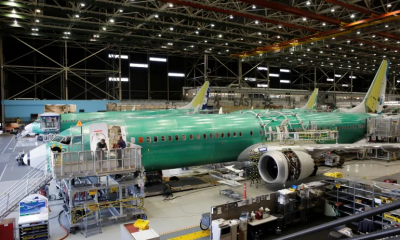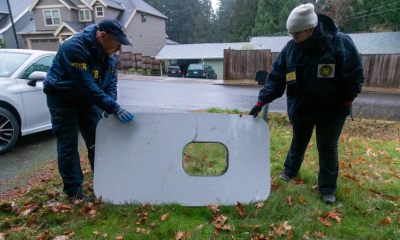Foreign News
Alaska Airlines grounds 737 Max 9 planes after section blows out mid-air
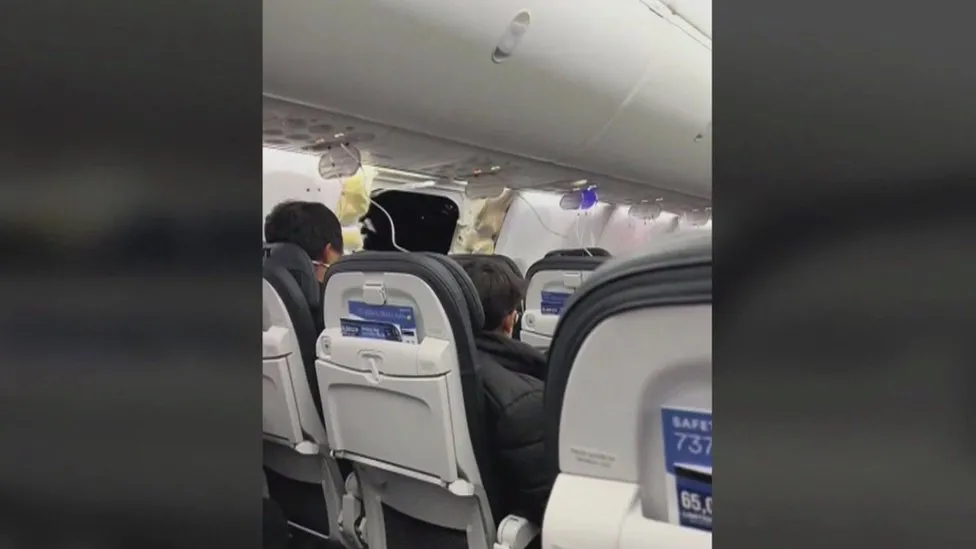
A passenger plane lost a section of its fuselage in mid-air forcing it to make an emergency landing in the US state of Oregon.
The Alaska Airlines Boeing 737 Max 9 turned back minutes into its flight to California after an outer section, including a window, fell off on Friday. There were 177 passengers and crew on board and it landed safely in Portland. The airline said it would temporarily ground all 65 of its 737 Max 9 aircraft to conduct inspections.
Boeing said it was aware of the incident and was “working to gather more information”.
The UK Civil Aviation Authority told the BBC it was “monitoring the situation very closely”.
Evan Smith, one of the 171 passengers on board, said: “There was a really loud bang towards the left rear of the plane and a woosh noise – and all the air masks dropped. “They said there was a kid in that row who had his shirt sucked off him and out of the plane and his mother was holding onto him to make sure he didn’t go with it.”
Diego Murillo said the gap was “as wide as a refrigerator”.
Fellow passenger Elizabeth Lee added: “Part of the plane was missing and the wind was just extremely loud. but everyone was in their seats and had their belt on.”
Jessica Montoia described the flight as a “trip from hell” adding a phone was taken out of a man’s hand by the wind.
Announcing the grounding of the 65 planes, Alaska Airlines’ CEO Ben Minicucci said: “Each aircraft will be returned to service only after completion of full maintenance and safety inspections. My heart goes out to those who were on this flight – I am so sorry for what you experienced. I am so grateful for the response of our pilots and flight attendants.”
The flight to Ontario, California, had reached 16,000ft (4,876m) when it began its emergency descent, according to flight tracking data. Images sent to news outlets show the night sky visible through the gap in the fuselage, with insulation material and other debris also seen.
Other pictures show the seat closest to the affected section, a window seat that passengers said was unoccupied, leaning forward without its cushion. In an audio clip, the pilot can be heard talking to air traffic control requesting a diversion. “We are an emergency,” she said. “We are depressurised, we do need to return back.”
According to photographs, the affected area was in the back third of the plane, behind the wing and engines. The section of fuselage involved appears to be an area that can be used as an additional emergency exit door by some operators, but not by Alaska.
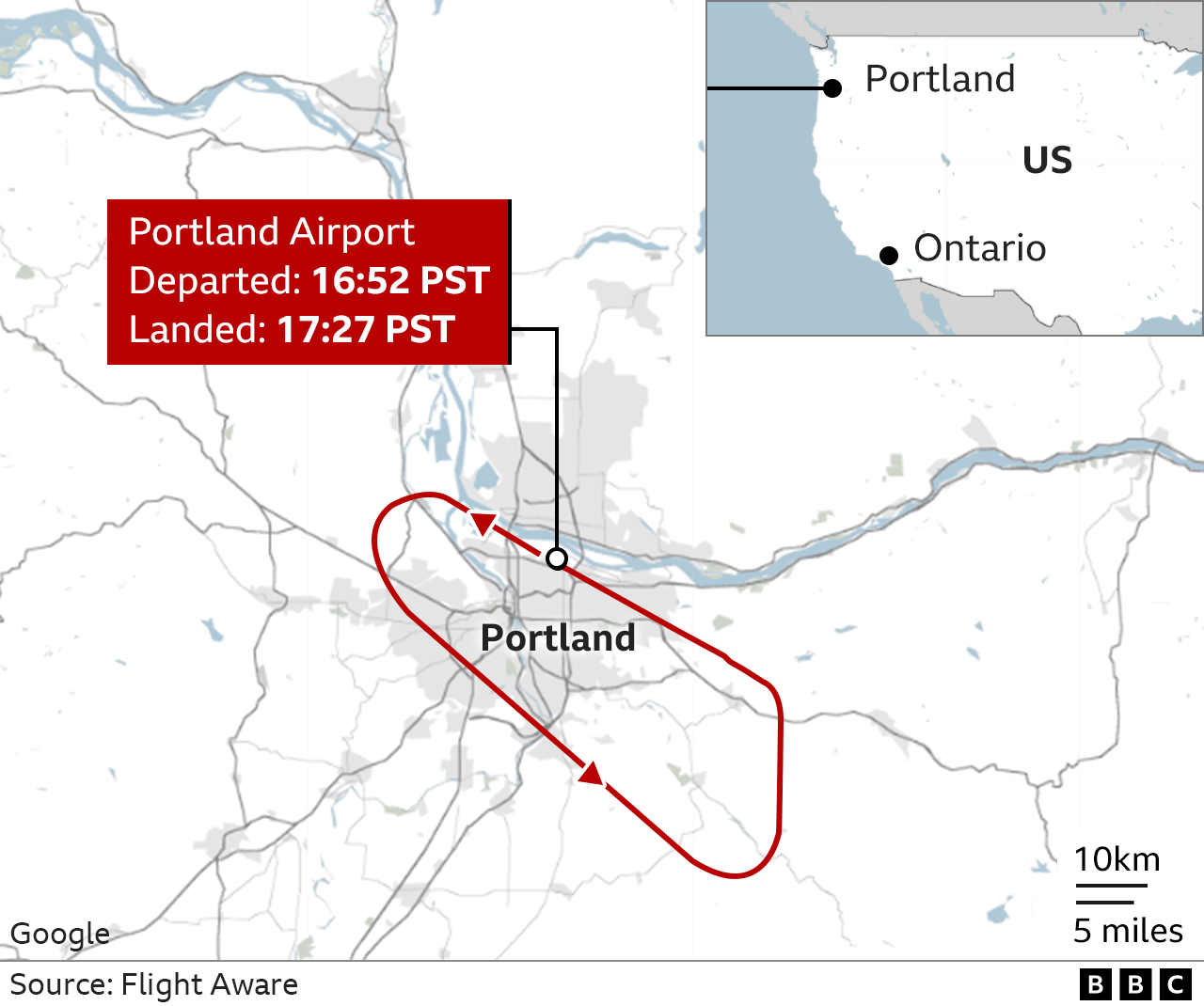
The US Federal Aviation Administration (FAA) confirmed Alaska Airlines Flight 1282 “returned safely… after the crew reported a pressurisation issue”.
Boeing said a “technical team stands ready to support the investigation”. Flydubai told the BBC that its three Boeing 737 Max 9 had a “different configuration with mid-aft cabin exits” compared to the Alaska Airline planes and have completed recent safety checks. “We will follow any guidance issued by Boeing once more information is available,” a spokeswoman added.
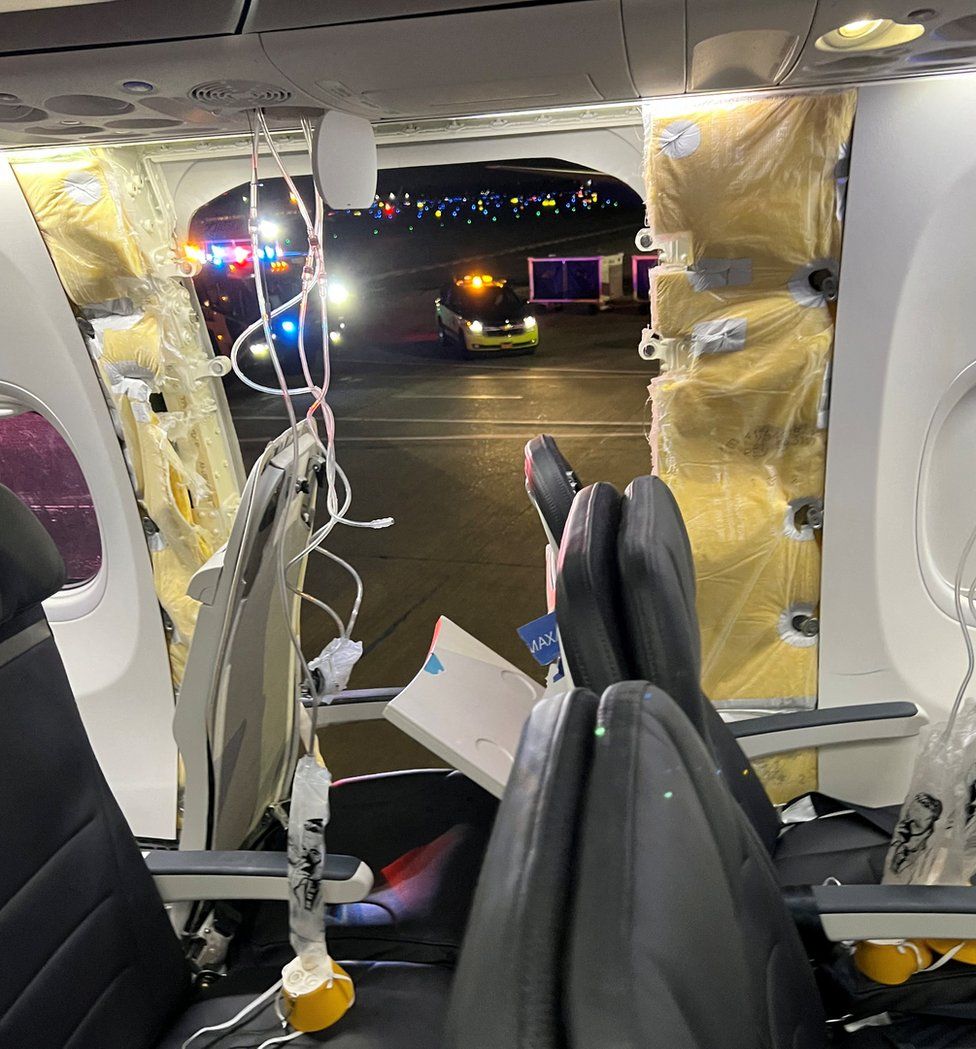
The National Transportation Safety Board (NTSB) is investigating the incident.
The Boeing 737 Max has been described as “the most scrutinised transport aircraft in history” after a series of safety issues. The Max was grounded in March 2019 for a year-and-a-half after two of the type crashed in similar circumstances to each other killing those on board.
Aviation expert John Strickland said the Alaska Airlines incident was very different to those crashes, adding that since the 737 Max came back into service it had “an enormous safety record”. “While we know little evidence of why this section of the fuselage has come out – this has nothing to do with the aircraft being grounded for 18 months,” he told BBC News. “But, it is natural Alaska Airlines is taking a cautious approach grounding its fleet”
More recently, Boeing said it would increase the pace of 737 Max deliveries after resolving a supply error that required it to conduct lengthy inspections of new planes and its inventory, Reuters news agency reported.
About 1,300 737 Max aircraft have been delivered to customers, Boeing data shows. Last month, the FAA urged airlines to inspect Max models for a possible loose bolt in rudder control systems.
(BBC)
Foreign News
Nasa ‘Earthrise’ astronaut dies at 90 in plane crash

Apollo 8 astronaut Bill Anders, who snapped one of the most famous photographs taken in outer space, has died at the age of 90.
Officials say a small plane he was flying crashed into the water north of Seattle, Washington.
Anders’ son Greg confirmed that his father was flying the small plane, and that his body was recovered on Friday afternoon. “The family is devastated. He was a great pilot. He will be missed,” a statement from the family reads.
Anders – who was a lunar module pilot on the Apollo 8 mission – took the iconic Earthrise photograph, one of the most memorable and inspirational images of Earth from space.
Taken on Christmas Eve during the 1968 mission, the first crewed space flight to leave Earth and reach the Moon, the picture shows the planet rising above the horizon from the barren lunar surface.
Anders later described it as his most significant contribution to the space programme.
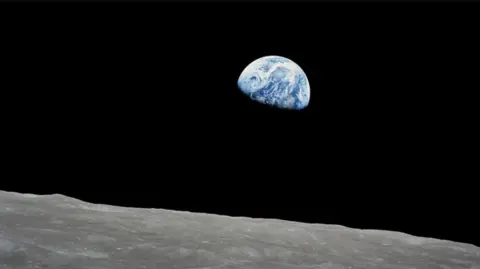
The image is widely credited with motivating the global environmental movement and leading to the creation of Earth Day, an annual event to promote activism and awareness of caring for the planet.
Speaking of the moment, Anders said: “We came all this way to explore the Moon, and the most important thing that we discovered was the Earth.”
Officials said on Friday that Anders crashed his plane around 11:40PDT (1940BST).
The US National Transportation Safety Board (NTSB) said the 90-year-old was flying a Beechcraft A A 45 – also known as a T-34. The agency said that the plane crashed about 80ft (25m) from the coast of Jones Island.
Anders also served as the backup pilot to the Apollo 11 mission, the name of the effort that led to the first Moon landing on July 24, 1969.
Following Anders’ retirement from the space programme in 1969, the former astronaut largely worked in the aerospace industry for several decades. He also served as US Ambassador to Norway for a year in the 1970s.
But he is best remembered for the Apollo 8 mission and the iconic photograph he took from space.
“In 1968, during Apollo 8, Bill Anders offered to humanity among the deepest of gifts an astronaut can give. He traveled to the threshold of the Moon and helped all of us see something else: ourselves,” Nasa Administrator Bill Nelson said in a statement.
Mark Kelly, a former astronaut who now serves as a US Senator for the state of Arizona, said in a post on X, formerly Twitter, that Anders “inspired me and generations of astronauts and explorers. My thoughts are with his family and friends”.
[BBC]
Foreign News
China’s Chang’e-6 lifts off from far side of Moon with rock samples

A Chinese spacecraft carrying rock and soil samples from the far side of the Moon has lifted off from the lunar surface to start its journey back to Earth, according to state media.
The achievement on Tuesday is a world first and the latest leap for Beijing’s decades-old space programme, which aims to send a crewed mission to the Moon by 2030.
The Xinhua News Agency, citing the China National Space Administration (CNSA), said that the ascender of the Chang’e-6 probe took off at 7:38am local time on Tuesday (23:38 GMT) and entered a preset orbit around the moon.
It described the move as “an unprecedented feat in human lunar exploration history”.
The Chang’e-6 probe was launched last month and its lander touched down on the far side of the Moon on Sunday. It used a drill and robotic arm to dig up soil on and below the Moon’s surface, according to Xinhua.
After successfully gathering its samples, the Chang’e-6 unfurled China’s national flag for the first time on the far side of the Moon, it said.
The agency cited the CNSA as saying that the spacecraft stowed the samples it had gathered in a container inside the ascender of the probe as planned.
[Aljazeera]
Foreign News
China says its spacecraft lands on Moon’s far side

China says its uncrewed craft has successfully landed on the far side of the Moon – an unexplored place almost no-one tries to go.
The Chang’e 6 touched down in the South Pole-Aitken Basin at 06:23 Beijing time on Sunday morning (22:23 GMT Saturday), the China National Space Administration (CNSA) said.
Launched on 3 May, the mission aims to collect precious rock and soil from this region for the first time in history. The probe could extract some of the Moon’s oldest rocks from a huge crater on its South Pole.
The landing was fraught with risks, because it is very difficult to communicate with spacecraft once they reach the far side of the Moon. China is the only country to have achieved the feat before, landing its Chang’e-4 in 2019.
After launching from Wenchang Space Launch Center, the Chang’e 6 spacecraft had been orbiting the Moon waiting to land. The lander component of the mission then separated from the orbiter to touch down on the side of the Moon that faces permanently away from Earth.
During the descent, an autonomous visual obstacle avoidance system was used to automatically detect obstacles, with a visible light camera selecting a comparatively safe landing area based on the brightness and darkness of the lunar surface, the CNSA was quoted as saying by state-run Xinhua news agency.
The lander hovered about 100m (328ft) above the safe landing area, and used a laser 3D scanner before a slow vertical descent. The operation was supported by the Queqiao-2 relay satellite, the CNSA said.
Chinese state media described the successful landing as an “historic moment”. The state broadcaster said “applause erupted at the Beijing Aerospace Flight Control Center” when the Chang’e landing craft touched down on the Moon early on Sunday morning.
The lander should spend up to three days gathering materials from the surface in an operation the CNSA said would involve “many engineering innovations, high risks and great difficulty”. “Everyone is very excited that we might get a look at these rocks no-one has ever seen before,” explains Professor John Pernet-Fisher, who specialises in lunar geology at the University of Manchester.
He has analysed other lunar rock brought back on the American Apollo mission and previous Chinese missions. But he says the chance to analyse rock from a completely different area of the Moon could answer fundamental questions about how planets form.
Most of the rocks collected so far are volcanic, similar to what we might find in Iceland or Hawaii. But the material on the far side would have a different chemistry . “It would help us answer those really big questions, like how are planets formed, why do crusts form, what is the origin of water in the solar system?” the professor says.
The mission aims to collect about 2kg (4.4lb) of material using a drill and mechanical arm, according to the CNSA.
The South Pole–Aitken basin, an impact crater, is one of the largest known in the solar system.
From there, the probe could gather material that came from deep inside the lunar mantle – the inner core of the Moon – Prof Pernet-Fisher says.
The Moon’s South Pole is the next frontier in lunar missions – countries are keen to understand the region because there is a good chance it has ice.
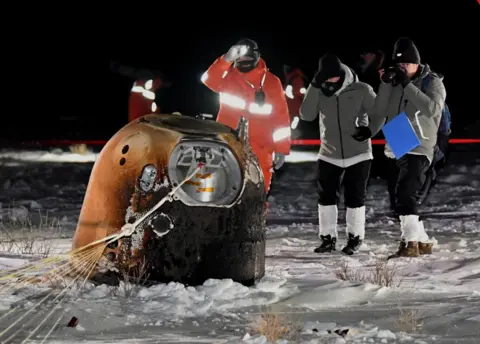
The capsule in the last Chinese moon mission, Chang’e 5, brought back soil and rocks in 2020 (BBC)
Access to water would significantly boost the chances of successfully establishing a human base on the Moon for scientific research.
If the mission succeeds, the craft will return to Earth with the precious samples on board a special return capsule.
The material will be kept in special conditions to try to keep it as pristine as possible.
Scientists in China will be given the first chance to analyse the rocks, and later researchers around the world will be able to apply for the opportunity too.
This is the second time China has launched a mission to collect samples from the Moon.
In 2020 Chang’e 5 brought back 1.7kg of material from an area called Oceanus Procellarum on the Moon’s near side.
China is planning three more uncrewed missions this decade as it looks for water on the Moon and investigates setting up a permanent base there.
Beijing’s broader strategy aims to see a Chinese astronaut walk on the moon by around 2030.
The US also aims to put astronauts back on the moon, with Nasa aiming to launch its Artemis 3 mission in 2026.
(BBC)


